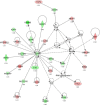Longissimus dorsi transcriptome analysis of purebred and crossbred Iberian pigs differing in muscle characteristics
- PMID: 24885501
- PMCID: PMC4070551
- DOI: 10.1186/1471-2164-15-413
Longissimus dorsi transcriptome analysis of purebred and crossbred Iberian pigs differing in muscle characteristics
Abstract
Background: The two main genetic types in Iberian pig production show important phenotypic differences in growth, fattening and tissue composition since early developmental stages. The objective of this work was the evaluation of muscle transcriptome profile in piglets of both genetic types, in order to identify genes, pathways and regulatory factors responsible for their phenotypic differences. Contemporary families coming from pure Iberian pigs (IB) or from crossing with Duroc boars (DU×IB) were generated. Piglets (14 from each genetic type) were slaughtered at weaning (28 days) and longissimus dorsi was sampled for composition and gene expression studies. RNA was obtained and hybridized to Affymetrix Porcine Genechip expression arrays.
Results: Loin muscle chemical composition showed significant differences between genetic types in intramuscular fat content (6.1% vs. 4.3% in IB and DUxIB animals, respectively, P = 0.009) and in saturated (P = 0.019) and monounsaturated fatty acid proportions (P = 0.044). The statistical analysis of gene expression data allowed the identification of 256 differentially expressed (DE) genes between genetic types (FDR < 0.10), 102 upregulated in IB and 154 upregulated in DU×IB. Transcript differences were validated for a subset of DE genes by qPCR. We observed alteration in biological functions related to extracellular matrix function and organization, cellular adhesion, muscle growth, lipid metabolism and proteolysis. Candidate genes with known effects on muscle growth were found among the DE genes upregulated in DU×IB. Genes related to lipid metabolism and proteolysis were found among those upregulated in IB. Regulatory factors (RF) potentially involved in the expression differences were identified by calculating the regulatory impact factors. Twenty-nine RF were found, some of them with known relationship with tissue development (MSTN, SIX4, IRX3), adipogenesis (CEBPD, PPARGC1B), or extracellular matrix processes (MAX, MXI1). Correlation among the expression of these RF and DE genes show relevant differences between genetic types.
Conclusion: These results provide valuable information about genetic mechanisms determining the phenotypic differences on growth and meat quality between the genetic types studied, mainly related to the development and function of the extracellular matrix and also to some metabolic processes as proteolysis and lipid metabolism. Transcription factors and regulatory mechanisms are proposed for these altered biological functions.
Figures




Similar articles
-
Developmental Stage, Muscle and Genetic Type Modify Muscle Transcriptome in Pigs: Effects on Gene Expression and Regulatory Factors Involved in Growth and Metabolism.PLoS One. 2016 Dec 9;11(12):e0167858. doi: 10.1371/journal.pone.0167858. eCollection 2016. PLoS One. 2016. PMID: 27936208 Free PMC article.
-
Comparative Analysis of Muscle Transcriptome between Pig Genotypes Identifies Genes and Regulatory Mechanisms Associated to Growth, Fatness and Metabolism.PLoS One. 2015 Dec 22;10(12):e0145162. doi: 10.1371/journal.pone.0145162. eCollection 2015. PLoS One. 2015. PMID: 26695515 Free PMC article.
-
Transcriptome analysis in comparing carcass and meat quality traits of Jiaxing Black Pig and Duroc × Duroc × Berkshire × Jiaxing Black Pig crosses.Gene. 2022 Jan 15;808:145978. doi: 10.1016/j.gene.2021.145978. Epub 2021 Sep 27. Gene. 2022. PMID: 34592352
-
Consequences of a low protein diet on the liver and longissimus dorsi transcriptome of Duroc × Iberian crossbred pigs.Animal. 2021 Dec;15(12):100408. doi: 10.1016/j.animal.2021.100408. Epub 2021 Dec 8. Animal. 2021. PMID: 34890881
-
Identification of differentially expressed genes in longissimus dorsi muscle between Wei and Yorkshire pigs using RNA sequencing.Genes Genomics. 2018 Apr;40(4):413-421. doi: 10.1007/s13258-017-0643-3. Epub 2017 Dec 19. Genes Genomics. 2018. PMID: 29892843
Cited by
-
IGFBP7 promotes the proliferation and differentiation of primary myoblasts and intramuscular preadipocytes in chicken.Poult Sci. 2024 Dec;103(12):104258. doi: 10.1016/j.psj.2024.104258. Epub 2024 Sep 2. Poult Sci. 2024. PMID: 39293261 Free PMC article.
-
Differences in the Loin Tenderness of Iberian Pigs Explained through Dissimilarities in Their Transcriptome Expression Profile.Animals (Basel). 2020 Sep 22;10(9):0. doi: 10.3390/ani10091715. Animals (Basel). 2020. PMID: 32971875 Free PMC article.
-
Enhanced identification of significant regulators of gene expression.BMC Bioinformatics. 2020 Apr 6;21(1):134. doi: 10.1186/s12859-020-3468-z. BMC Bioinformatics. 2020. PMID: 32252623 Free PMC article.
-
Changes in Biceps femoris Transcriptome along Growth in Iberian Pigs Fed Different Energy Sources and Comparative Analysis with Duroc Breed.Animals (Basel). 2021 Dec 8;11(12):3505. doi: 10.3390/ani11123505. Animals (Basel). 2021. PMID: 34944282 Free PMC article.
-
Comparative Transcriptome Profile Analysis of Longissimus dorsi Muscle Tissues From Two Goat Breeds With Different Meat Production Performance Using RNA-Seq.Front Genet. 2021 Jan 13;11:619399. doi: 10.3389/fgene.2020.619399. eCollection 2020. Front Genet. 2021. PMID: 33519920 Free PMC article.
References
-
- Hausman GJ, Dodson MV, Ajuwon K, Azain M, Barnes KM, Guan LL, Jiang Z, Poulos SP, Sainz RD, Smith S, Spurlock M, Novakofski J, Fernyhough ME, Bergen WG. The biology and regulation of preadipocytes and adipocytes in meat animals. J Anim Sci. 2009;87:1218–1246. doi: 10.2527/jas.2008-1427. - DOI - PubMed
Publication types
MeSH terms
LinkOut - more resources
Full Text Sources
Other Literature Sources
Molecular Biology Databases
Miscellaneous

